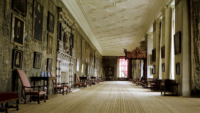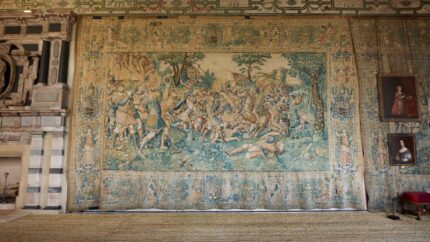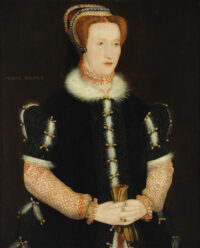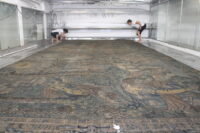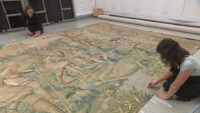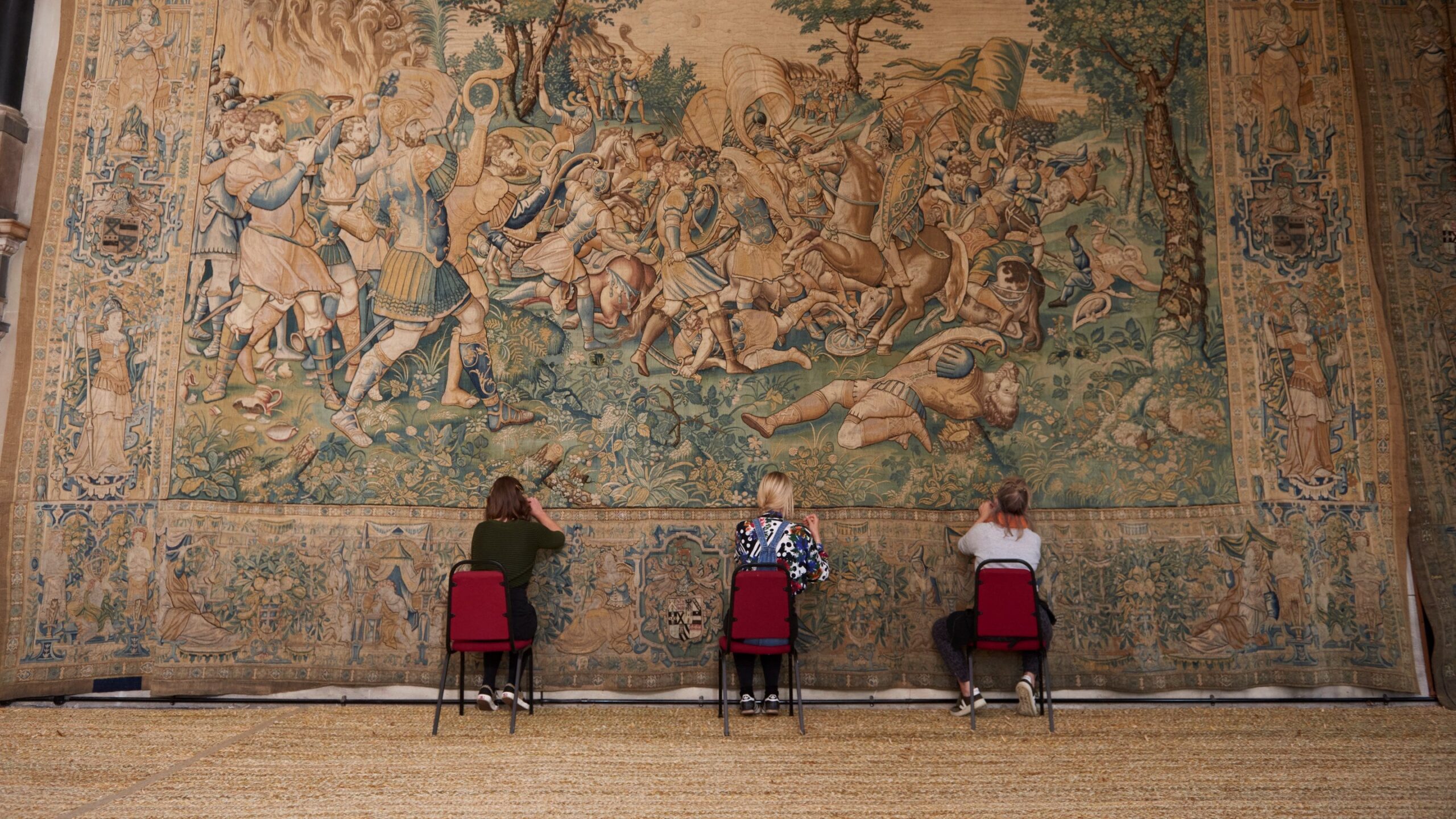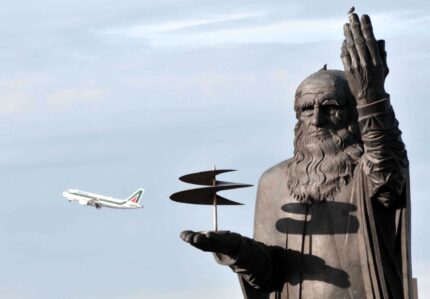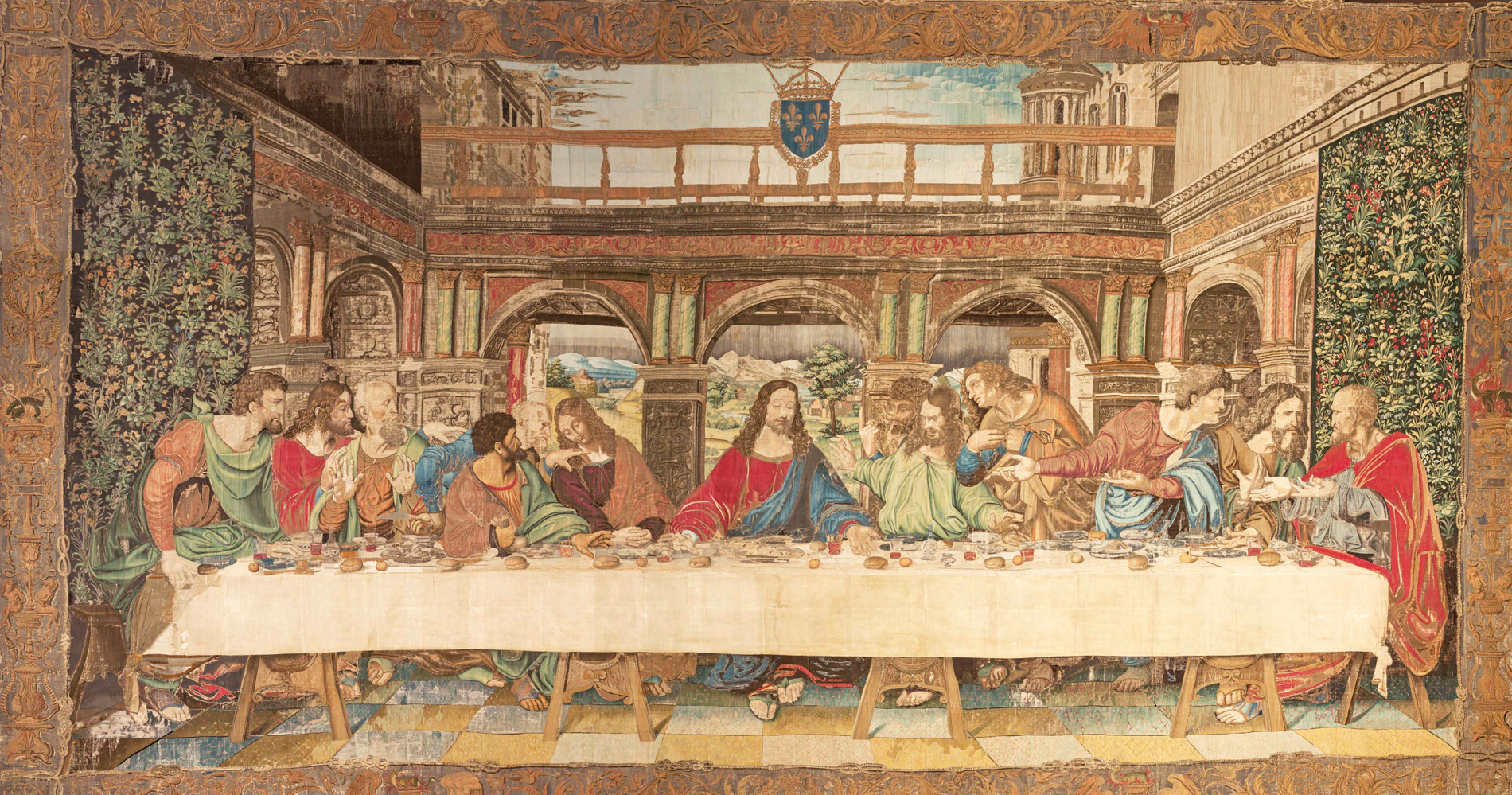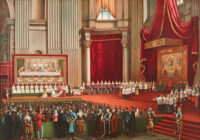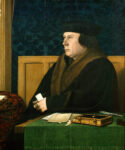
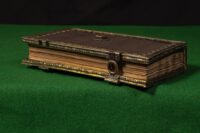 New research has found that a luxurious printed and illuminated Book of Hours in the Wren Library of Trinity College, Cambridge, belonged to Thomas Cromwell, Chief Minister of King Henry VIII until his boss had him beheaded in 1540. The attribution is confirmed by an unimpeachable source: a portrait of Cromwell by Henry’s court painter Hans Holbein the Younger in 1532-3. The book is the only object depicted in a 16th century portrait known to survive.
New research has found that a luxurious printed and illuminated Book of Hours in the Wren Library of Trinity College, Cambridge, belonged to Thomas Cromwell, Chief Minister of King Henry VIII until his boss had him beheaded in 1540. The attribution is confirmed by an unimpeachable source: a portrait of Cromwell by Henry’s court painter Hans Holbein the Younger in 1532-3. The book is the only object depicted in a 16th century portrait known to survive.
The Book of Hours was printed on vellum in Paris by Germain Hardouyn in 1527/8. After printing, hand-painted illuminations were added. It was then bound in a sumptuous velvet cover with silver gilt edges and clasps (one clasp now missing). Central boxes on the front and back covers and the clasps were each set with a large garnet.
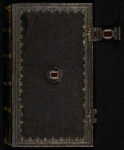 It was one of three known copies printed by Hardouyn in the same run. The other two went to no lesser personages than Catherine of Aragon and Anne Boleyn. This example is the only one of the three still in its original binding. The books were personalized for their owners, so even though they were from the same print batch, they were not identical. The printed texts are the same, but the illuminations were hand-painted and they reflect the tastes (and budgets?) of their owners. Anne’s Book of Hours is larger and has the deluxe illumination package: the drawings are more ornate and detailed with extra decoration in the borders. Catherine’s is the least elaborately decorated. Cromwell’s is in between the two queens’ in richness of detail.
It was one of three known copies printed by Hardouyn in the same run. The other two went to no lesser personages than Catherine of Aragon and Anne Boleyn. This example is the only one of the three still in its original binding. The books were personalized for their owners, so even though they were from the same print batch, they were not identical. The printed texts are the same, but the illuminations were hand-painted and they reflect the tastes (and budgets?) of their owners. Anne’s Book of Hours is larger and has the deluxe illumination package: the drawings are more ornate and detailed with extra decoration in the borders. Catherine’s is the least elaborately decorated. Cromwell’s is in between the two queens’ in richness of detail.
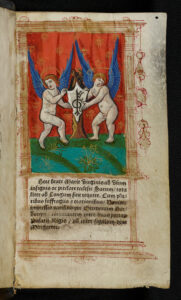 That Anne, Catherine and Thomas all had the same Latin prayer book underscores how fluid the lines were between the practices of English Catholics and the Protestant reformers at this time. The three held very different beliefs; even the two Protestants Anne and Cromwell diverged significantly on doctrinal matters. Yet, Cromwell owned, used and celebrated the traditionally Catholic text, showing it off front and center on his prestigious portrait by the king’s favorite painter.
That Anne, Catherine and Thomas all had the same Latin prayer book underscores how fluid the lines were between the practices of English Catholics and the Protestant reformers at this time. The three held very different beliefs; even the two Protestants Anne and Cromwell diverged significantly on doctrinal matters. Yet, Cromwell owned, used and celebrated the traditionally Catholic text, showing it off front and center on his prestigious portrait by the king’s favorite painter.
The Book of Hours was donated to the library of Trinity College in 1660 by Anne Sadler or Sadleir, wife of Ralph, a wealthy landowner whose grandfather was Sir Ralph Sadler, Thomas Cromwell’s secretary and successor as Secretary of State to Henry VIII. Ralph had been raised in Cromwell’s household since he was seven years old. Cromwell was a mentor and teacher to him and they were close friends throughout his lifetime. Sir Ralph Sadler was the executor of Cromwell’s will and, even more directly on-point, was named in the will as the recipient of all of his former mentor’s books.
Anne Sadler was also closely connected to the Tudor court (her father had been Elizabeth I’s Attorney General and later Lord Chief Justice) and was an avid collector of books and coins. Over the course of two decades (1649-1669), she donated her correspondence, diaries, manuscripts and books to Trinity College, Cambridge, which her father had attended. The Book of Hours with silver gilt borders and garnet gemstones was donated along with The Trinity Apocalypse, the college’s most famous illuminated manuscript.
The Books of Hours were probably commissioned and gifted to the recipients by a single individual. This person must have had very deep pockets to afford at least three of these extremely expensive luxury items, and a connection to all three parties. That narrows down the likely candidates to Henry or Anne herself.
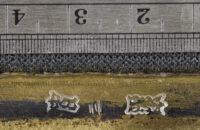 Using the hallmarks on the silver binding, researchers were able to discover the maker of the silver and gemstone binding. They looked through whole books of makers’ marks to determine they weren’t English, Dutch or Flemish. Then, with the aid of French experts, the maker was identified as Pierre Mangot of Blois, goldsmith to King Francis I of France, who made the binding in 1529-30.
Using the hallmarks on the silver binding, researchers were able to discover the maker of the silver and gemstone binding. They looked through whole books of makers’ marks to determine they weren’t English, Dutch or Flemish. Then, with the aid of French experts, the maker was identified as Pierre Mangot of Blois, goldsmith to King Francis I of France, who made the binding in 1529-30.
Anne spent the late 1510s and early 20s at the court of Francis I; this is where she was educated in literature, religion and the arts, developing a strong interest in illuminated manuscripts. She was maid of honor (a sort of junior lady-in-waiting) to Francis’ wife Queen Claude for seven years before returning to England in 1522. She knew Pierre Mangot, a fact supported by a chain Anne’s brother George had Mangot make for him a few years later.
 Given the persistent connections between the Boleyn family and Francis’ goldsmith, and how extra-fancy Anne’s version of the Book of Hours is, it’s probable she commissioned the printing and gifted the copies to Cromwell and Catherine (who was at this time still married to Henry but had been publicly sidelined in favor of Anne while the king sought his annulment).
Given the persistent connections between the Boleyn family and Francis’ goldsmith, and how extra-fancy Anne’s version of the Book of Hours is, it’s probable she commissioned the printing and gifted the copies to Cromwell and Catherine (who was at this time still married to Henry but had been publicly sidelined in favor of Anne while the king sought his annulment).
Cromwell’s Book of Hours will go on display at Hever Castle, childhood home of Anne Boleyn, where her copy is part of the permanent collection. Catherine’s copy belongs to The Morgan Library in New York City, but it was recently on loan at Hever, exhibited side-by-side with Anne’s for the first time. Catherine’s was returned to The Morgan just a week ago, so Cromwell’s is stepping in to the breach. Trinity College has digitized the Book of Hours for virtual visitors to browse.
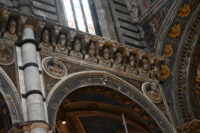 A section of the cornice overlooking the Presbytery of the Cathedral of Siena that is decorated with the busts of 171 popes was subject to an urgent intervention when cracks were discovered in two of the travertine slabs. A number of cracks, large and small, were spotted in June by a crew from the Acrobatic Monuments Construction company, specialists who use a double safety rope climbing technique to inspect and repair monuments. The cracks required immediate attention from the expert stone restorers of the Metropolitan Works of Siena, the municipal organization which oversees the cathedral.
A section of the cornice overlooking the Presbytery of the Cathedral of Siena that is decorated with the busts of 171 popes was subject to an urgent intervention when cracks were discovered in two of the travertine slabs. A number of cracks, large and small, were spotted in June by a crew from the Acrobatic Monuments Construction company, specialists who use a double safety rope climbing technique to inspect and repair monuments. The cracks required immediate attention from the expert stone restorers of the Metropolitan Works of Siena, the municipal organization which oversees the cathedral.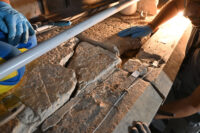 Scaffolding was erected in two days, taking measures to protect the extraordinarily ornate marble inlay floor, which is usually covered for its own protection but happened to be in one of only two brief periods a year when it is exposed in all its glory to the visiting public. The urgency of the intervention and its own potential dangers were underscored when a 3.8 magnitude earthquake struck on the first day conservators were at work on the scaffolding 60 feet above the floor. All personnel were forced to dismount and wait for the all-clear. The next day work resumed on repairing the fractures and consolidating the damaged stone elements. The team was able to complete the work in four weeks. The scaffolding was dismantled in time for the last days of the floor’s uncovering.
Scaffolding was erected in two days, taking measures to protect the extraordinarily ornate marble inlay floor, which is usually covered for its own protection but happened to be in one of only two brief periods a year when it is exposed in all its glory to the visiting public. The urgency of the intervention and its own potential dangers were underscored when a 3.8 magnitude earthquake struck on the first day conservators were at work on the scaffolding 60 feet above the floor. All personnel were forced to dismount and wait for the all-clear. The next day work resumed on repairing the fractures and consolidating the damaged stone elements. The team was able to complete the work in four weeks. The scaffolding was dismantled in time for the last days of the floor’s uncovering.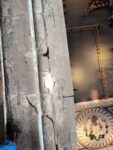 The Cornice of the Popes lines the central nave and choir of the Metropolitan Cathedral of Santa Maria Assunta, aka the Duomo of Siena. They were made by unknown artists between 1497 and 1502. The papal busts begin with Peter on the right of a bust of Christ. It runs clockwise chronologically with every successive pontiff concluding with Lucius III, pope between 1181 and 1185.
The Cornice of the Popes lines the central nave and choir of the Metropolitan Cathedral of Santa Maria Assunta, aka the Duomo of Siena. They were made by unknown artists between 1497 and 1502. The papal busts begin with Peter on the right of a bust of Christ. It runs clockwise chronologically with every successive pontiff concluding with Lucius III, pope between 1181 and 1185.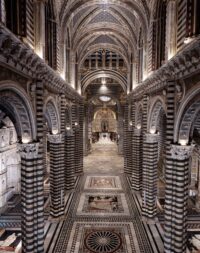 The final pope was originally supposed to be the one before Lucius, Alexander III (1159-1181), because he was a native of Siena and consecrated the cathedral in 1179. Lucius was added after the bust of Pope John VIII (872-882) was removed because he was confused for one of the church’s mythical medieval scandals: the female Pope Joan, who, legend has it, reigned under the pontifical name John VIII from 855 to 857, only to be exposed when she gave birth on the streets of Rome after being thrown from her horse. The myth of Pope Joan had long been refuted when the cornice was made, but the legend persisted and the actual John VIII paid the iconographic price.
The final pope was originally supposed to be the one before Lucius, Alexander III (1159-1181), because he was a native of Siena and consecrated the cathedral in 1179. Lucius was added after the bust of Pope John VIII (872-882) was removed because he was confused for one of the church’s mythical medieval scandals: the female Pope Joan, who, legend has it, reigned under the pontifical name John VIII from 855 to 857, only to be exposed when she gave birth on the streets of Rome after being thrown from her horse. The myth of Pope Joan had long been refuted when the cornice was made, but the legend persisted and the actual John VIII paid the iconographic price.